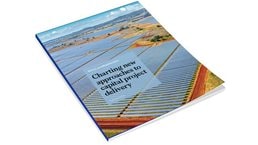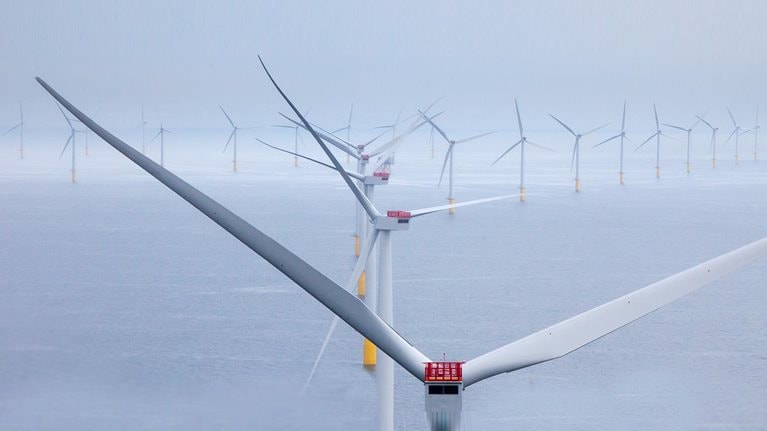Among the most notable results of the 2021 United Nations Climate Change Conference in Glasgow (COP26) was a global consensus on the reality and severity of climate change as well as on the urgency and scope of the capital investments required. What happens next depends on how well the global projects ecosystem responds.
Each of the three systems that form the broader construction ecosystem can help deliver the promise of net-zero emissions and reach the goal of limiting warming to 1.5°C above preindustrial levels.1 First, the political system—representing citizens, consumers, and community members—can ensure that government and local policies support net-zero investments. Next, the financial system—the global network of asset owners, investors, lenders, and insurers—can ensure that the necessary funding is available. Finally, the project delivery system—the global network of developers, operators, technology providers, engineers, constructors, service providers, and suppliers—can provide the $9.2 trillion of capital expenditures needed each year from 2022 to 2050 to achieve the desired results.2
The political system is making progress. At COP26, leaders from more than 100 countries representing more than 85 percent of the world’s forests made pledges to halt and reverse deforestation by 2030.3 And in the United States, the 2021 Infrastructure Investment and Jobs Act (IIJA) provides new funding for clean-energy technology, electric-vehicle charging infrastructure, and transmission lines for renewable energy. The financial system is also moving quickly. In fact, the Glasgow Financial Alliance for Net Zero (GFANZ), a global coalition of leading financial institutions representing $130 trillion in assets, has committed to reaching net zero by 2050.
The global project delivery system now has a critical role to play in completing this massive portfolio of projects. This article provides an overview of the challenges facing players in this system and of the opportunities to reduce the cost, time to completion, and risks of each project. Moving forward, the sector will need to collaborate and transform to help deliver net-zero emissions.
Would you like to learn more about our Global Infrastructure Initiative?
Global transformation challenges
The net-zero project portfolio calls for an extraordinary level of construction activity to be sustained for the next 30 years. Expectations are high, and the industry will need to deliver large and complex projects rapidly, cost effectively, and with a low carbon footprint. In addition, the capital projects sector faces unprecedented challenges in five areas: speed, predictability, technology, capacity, and safety and the environment.
Speed
Given the typically long duration of infrastructure projects, 30 years is a short time in which to complete the net-zero portfolio. Fortunately, the urgency of decarbonization is prompting policy changes such as the One Federal Decision (OFD) provision in the IIJA, which aims to reduce the cumbersome and complex permitting process to two years (from the five to ten years typical today). The projects sector will need to transform its work and decision processes to enable net-zero projects to move faster through the investment-decision stages. It will also need to reimagine design and construction methods to reverse declining productivity trends.
Predictability
Political and financial stakeholders will expect predictable cost and schedule outcomes from investments in decarbonization, but the project delivery system has a long history of unanticipated cost overruns and delays. Transformations in scope and risk management are needed to address root causes of unpredictable results as well as the new uncertainties created by rapid scale-up of new technologies, accelerated schedules, increased resource requirements and constraints, conflicting stakeholder priorities, and continuing stresses to the supply chain.
Technology
New decarbonization technologies are advancing rapidly and will add complexity to engineering, construction, and operations planning and resourcing. The industry will need to transform its processes for maturing technology and quickly apply digital and analytics to accelerate the progression of clean-energy and infrastructure facilities.
Capacity
Supporters of the net-zero project portfolio will likely expect every part of the project delivery system to include the people, skills, and production facilities needed to design and execute the increase in global project activity. To meet this expectation, owners or operators and engineering, construction, and specialty service providers will need to undertake organizational transformations.
Safety and the environment
Despite the increased need for speed in project development and delivery, the industry’s high standards for safety performance cannot be compromised. Furthermore, construction is directly or indirectly responsible for almost 40 percent of global CO₂ emissions from fuel combustion and 25 percent of greenhouse gas emissions overall.4 Achieving net zero thus will require transformation in areas such as concrete supply to drive improvements in the industry’s environmental impact. Transformations in practices, oversight, permitting, and compliance are also needed to ensure that high environmental standards are met even as capacity is expanded and projects are accelerated.
The need for collaboration
The time to start these vital transformations is now. The global project delivery system has a mandate to address its long-standing challenge of cost overruns and delays while making use of its impressive technical and project management capabilities. Even under the best circumstances, timelines for energy and infrastructure projects can span a decade or more. If players fail to act quickly, the resulting backlog of projects could further heighten the difficulties of meeting the net-zero goal.
Rapid mobilization of global leaders is required to ensure a timely start. GFANZ provides a good example of an industry sector collaborating globally to enable rapid, substantive transformation. Launched in April 2021, GFANZ already has 450 members from 45 countries. This coalition of financial-system actors has implemented a collaboration model that will enable financing of the net-zero portfolio, methodologies for businesses to use, and a set of standards and metrics to enable the necessary governance.
Like the financial system, the global project delivery system is highly segmented, yet all actors share the same goals and challenges. As with GFANZ, the urgency of net zero could inspire a new level of collaboration.

Voices on Infrastructure: Charting new approaches to capital project delivery
How the net-zero portfolio can improve project development and delivery
Despite the aforementioned challenges, the size and duration of the 30-year net-zero project portfolio presents unprecedented opportunities to reduce the cost, time, and risk of each project while continuously improving overall performance. Imagine the $9.2 trillion in capital expenditures each year as a portfolio of projects, organized by region and type of project. Grouping the portfolio into these subsets of similar projects or locations highlights five strategic levers that can help enable the industry’s transformation.
Certainty
A predictably large level of investment sustained over decades can reduce uncertainties for owners, suppliers, and service providers. With increased confidence in cost and revenue projections, organizations can make investments in human resources and supplier production facilities more cost effectively and with lower risk.
Standardization
Defining subsets of similar, repetitive projects can enable top-down standardization synergies that can reduce cost, time, and risk. Examples include standard designs that can be easily replicated, standardized methods for the adaptation of new technologies, and repeatable organization models for long-term agreements with critical suppliers and service providers. By reducing the uncertainty of investment decisions, standardization can also enable acceleration of the project definition process, while the repeatability of design and construction activities reduces execution time.
Optimization
The long-term perspective enables investments to define new or better ways to optimize designs, construction methods, contracting models, work processes, metrics, and reporting formats. Supply chain agreements and models for allocating responsibilities and risks can also be optimized based on long-term commitments, while multiyear continuous improvement programs can result in constantly improved efficiencies.
Innovation
The size and duration of the net-zero capital expenditure portfolio reduce the risk of investments in innovation, including R&D, piloting and scaling up, and rollout. With its repeatable project designs, the portfolio provides an unprecedented framework in which new ideas can be rapidly tested, evaluated, and improved.
Policy
As both a source of project and financial risk and a way to mitigate risk, successful decarbonization requires clarity and consistency at all levels and areas of government policy. Transforming the project delivery system can help clarify the impact of policy on net-zero project outcomes, help set priorities, and support needed changes.
COP26 made it clear: global leaders have a mandate to address climate change. Government and financial industry leaders are at the forefront of this charge. Now, by initiating a collaborative transformation process, participants in the project delivery system can do their part and become indispensable partners as the world builds the energy and civil infrastructure needed to achieve net zero.
This is the first in a series of six bimonthly articles providing a deep dive into global transformation challenges.


